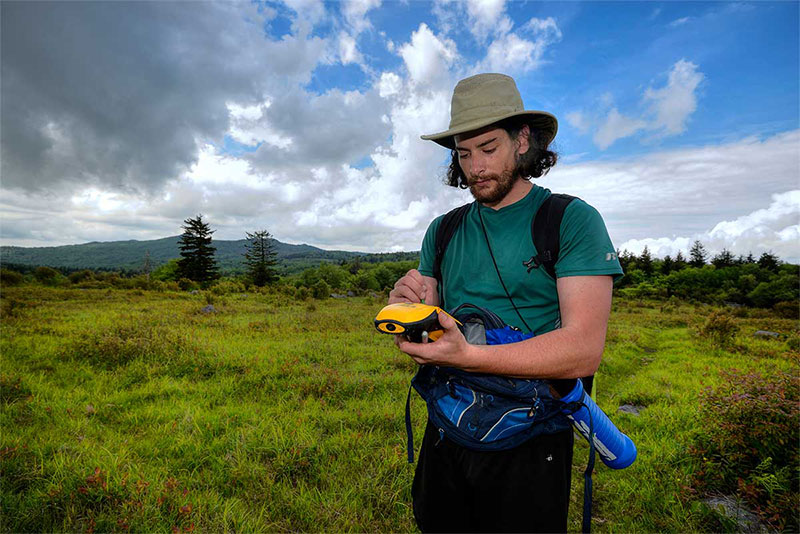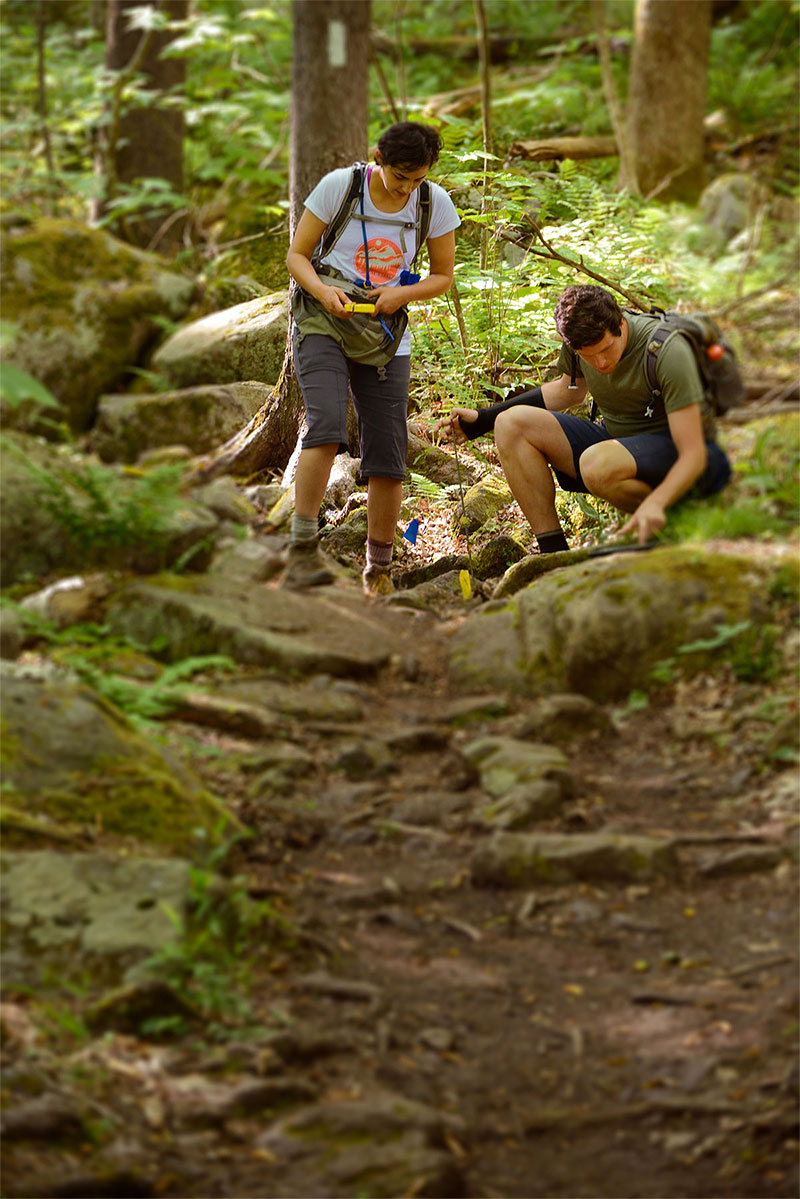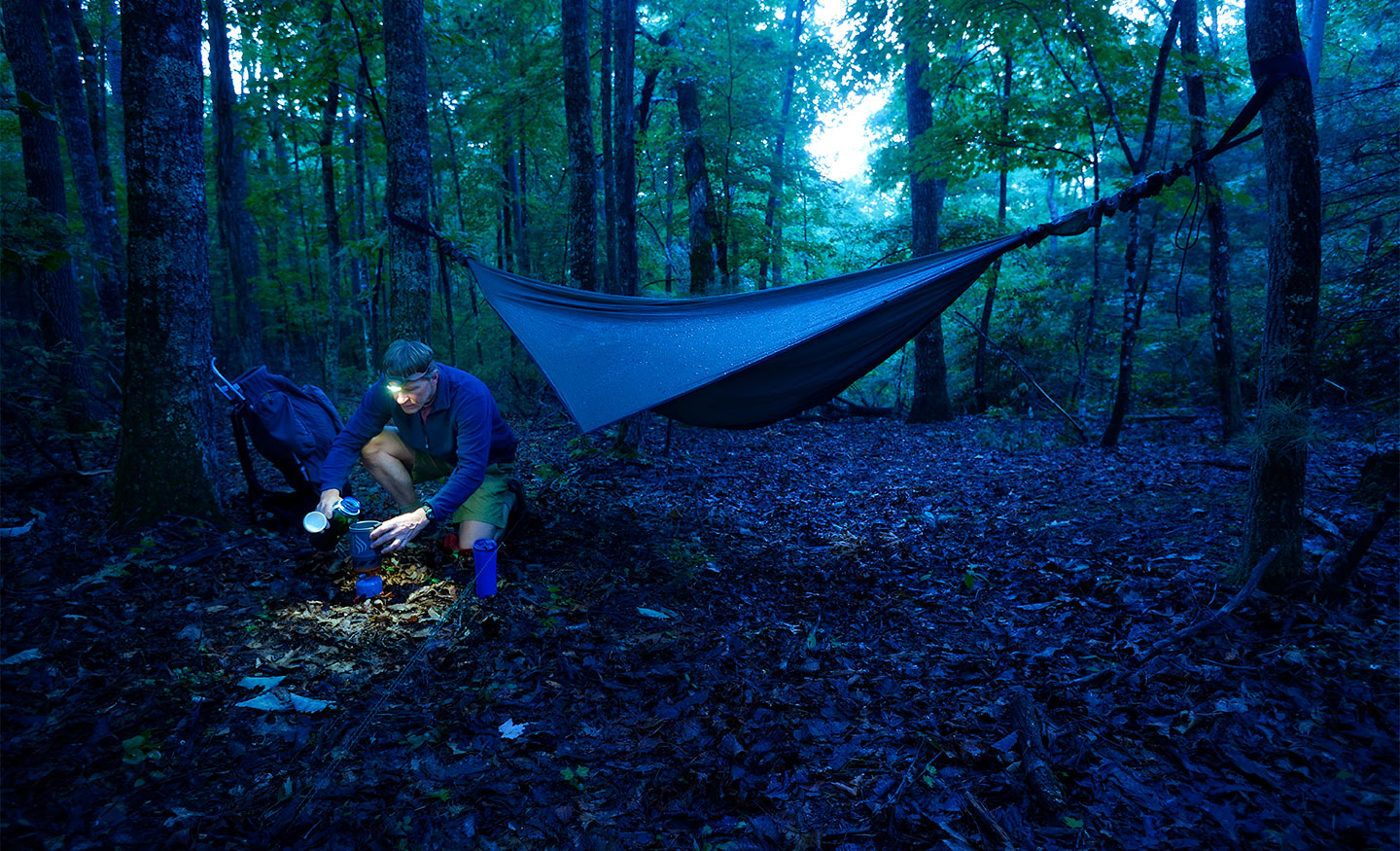by Jesse Tuel
Photos by Jim Stroup
Virginia Tech's Jeff Marion embodies the Leave No Trace principles of hiking (on which he, as a founding member of the organization, quite literally wrote the book,) by hammock-amping to minimize his footprint. Pictured above in July near the Appalachian Trail's southern terminus in Georgia, where a growing number of hikers are affecting the environment, Marion met his research team as they wrapped up their second summer of measuring trail conditions.
Walk in the woods for long enough and the games will begin.
Along the Appalachian Trail (AT) this summer, thru-hikers — those hiking the entire 2,185 miles from Georgia to Maine or vice versa — might have encountered a trio of Virginia Tech researchers armed with stakes and measuring tape and various electronic gadgetry. Being long-distance hikers themselves, the researchers couldn't help but test the gullibility of hikers who encountered one of the transect lines placed across and above the trail tread.
The project was to measure average step height, the researchers would say. Or problem-solving abilities in the woods. Or smells. Yes, that's it: a hiker smell-o-meter.
"They're losing it right now," said Mitchell Rosen, a senior in the College of Natural Resources and Environment (CNRE), of the thru-hiker mindset. He chuckled, and then paused. "So are we, maybe."

High point
At an elevation approaching 5,000 feet, CNRE senior Mitchell Rosen surveys a recreational site near Mt. Rogers, the highest point in Virginia at 5,729 feet.
In truth, the transect lines were measuring the trail itself. The research project is a three-year study funded by the National Park Service to characterize and help reduce the impact of millions of AT hikers on the trail tread, campsites, and shelters by assessing and evaluating the sustainability of trail alignments, camping locations, and management practices.
Led by Jeff Marion, an adjunct professor in the College of Natural Resources and Environment since 1989 and a research ecologist with the U.S. Geological Survey, the team examined 1,050 transect lines within 21 randomly selected 5-kilometer stretches along the AT's northern third in 2015, and 21 stretches in the southern third this year, with plans to measure the middle third in 2017.
On June 2, the ninth day of the summer's work, Rosen — along with CNRE graduate student and team leader Johanna Arredondo (forestry, natural resources conservation '13) and field staff member Fletcher Meadema — tackled the sixth segment, located just north of Grayson Highlands State Park and just east of Mt. Rogers, the highest point in Virginia. Southbound from the Old Orchard shelter, when a Trimble GPS device buzzed to tell Meadema (architecture '12) that he had reached one of the segment's preprogrammed sites, he stopped to begin assessing trail conditions. At the spot, pooling rain runoff had caused a mud hole, effectively widening the trail as hikers step around it, pulverizing leaves and vegetation outside of the original path.
At each and every point, the team collected specific data — on soil loss, watershed boundaries, slope, and more. "I find this project fascinating. I love it," Fletcher said. "But there is an element of monotony."
Of course, a hiker will tell you that's the beauty of hiking. Best yet, the team will end up with the first comprehensive data set of the trail's conditions, along with statistical modeling and analyses that will improve the sustainability of the AT's tread and camping locations.
One step forward
As part of a three-year federal grant, team leader and graduate student Johanna Arredondo '13 and Fletcher Meadema '12 measure Appalachian Trail conditions north of Grayson Highlands State Park.

As part of a three-year federal grant, team leader and graduate student Johanna Arredondo '13 and Fletcher Meadema '12 measure Appalachian Trail conditions north of Grayson Highlands State Park.
As part of a three-year federal grant, team leader and graduate student Johanna Arredondo '13 and Fletcher Meadema '12 measure Appalachian Trail conditions north of Grayson Highlands State Park.
Three Tech faculty members — John Jelesko and David Haak in the College of Agriculture and Life Sciences and CNRE's Lynn Resler — are studying the hiker's arch nemesis: poison ivy.
